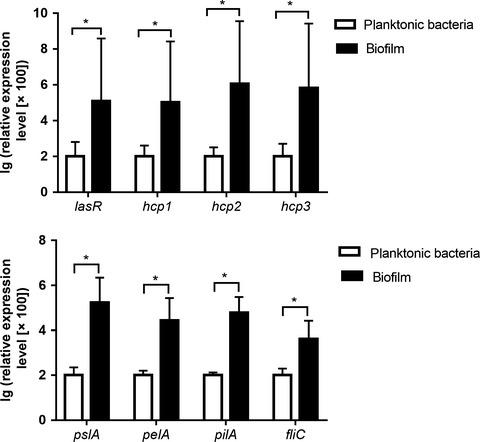当前位置:
X-MOL 学术
›
Microbiologyopen
›
论文详情
Our official English website, www.x-mol.net, welcomes your
feedback! (Note: you will need to create a separate account there.)
Type VI secretion system of Pseudomonas aeruginosa is associated with biofilm formation but not environmental adaptation.
MicrobiologyOpen ( IF 3.9 ) Pub Date : 2020-01-21 , DOI: 10.1002/mbo3.991 Lihua Chen 1 , Yaru Zou 1 , Asmaa Abbas Kronfl 1 , Yong Wu 1
MicrobiologyOpen ( IF 3.9 ) Pub Date : 2020-01-21 , DOI: 10.1002/mbo3.991 Lihua Chen 1 , Yaru Zou 1 , Asmaa Abbas Kronfl 1 , Yong Wu 1
Affiliation

|
Pseudomonas aeruginosa encodes three type VI secretion systems (T6SSs), namely H1‐, H2‐, and H3‐T6SS. P. aeruginosa hemolysin‐coregulated protein (Hcp) is the effector protein and the hallmark of T6SS. Although T6SS is ubiquitous and affects ecology and human health, its general mechanism and physiological role are still not fully understood. Therefore, in this study, we investigated the impact of the P. aeruginosa T6SS on biofilm formation and environmental adaptation. To this end, we collected P. aeruginosa clinical isolates, divided them into strong biofilm formation (SBF) and nonbiofilm formation (NBF) groups based on their biofilm‐forming ability, and compared their associated clinical characteristics. The duration of hospitalization was longer in patients infected with SBF than those infected with NBF strains. The expression levels of T6SS‐related genes (hcp1 and hcp3) and a quorum‐sensing gene (lasR) were higher in the SBF group as compared to those in the NBF group. In addition, the expression level of lasR was negatively associated with that of hcp1, but was positively associated with those of hcp2 and hcp3. Moreover, we evaluated the expression of T6SS‐ and biofilm‐associated genes in planktonic and biofilm cells of the P. aeruginosa strain PAO1, and constructed strain PAO1△clpV1 to study the adaptation characteristics of H1‐T6SS. The expression levels of hcp1, hcp2, hcp3, lasR, and other biofilm‐associated genes were significantly higher in PAO1 biofilm cells as compared to those of planktonic cells. However, except for swarming ability as a vital feature for biofilm formation, there were no significant differences in the biofilm‐forming ability and expression of biofilm‐associated genes, adherence ability, growth characteristics, resistance to acid and osmotic pressure, surface structure, and morphology between the PAO1△clpV1 and PAO1 wild‐type strains. Collectively, our results suggest that T6SS might play a role in biofilm formation and that H1‐T6SS does not contribute to environmental adaptation in P. aeruginosa.
中文翻译:

铜绿假单胞菌的VI型分泌系统与生物膜形成有关,但与环境适应性无关。
铜绿假单胞菌编码三种VI型分泌系统(T6SS),即H1-,H2-和H3-T6SS。铜绿假单胞菌溶血素核心蛋白(Hcp)是效应蛋白,是T6SS的标志。尽管T6SS无处不在,并影响生态和人类健康,但其一般机制和生理作用仍未完全了解。因此,在这项研究中,我们调查了铜绿假单胞菌T6SS对生物膜形成和环境适应的影响。为此,我们收集了铜绿假单胞菌临床分离株,根据其生物膜形成能力将其分为强生物膜形成(SBF)和非生物膜形成(NBF)组,并比较其相关的临床特征。感染SBF的患者的住院时间比感染NBF菌株的患者更长。与NBF组相比,SBF组中T6SS相关基因(hcp1和hcp3)和群体感应基因(lasR)的表达水平更高。此外,表达水平LASR呈负与该相关联的HCP1,但是与那些呈正相关hcp2和hcp3。此外,我们评估了铜绿假单胞菌PAO1菌株浮游和生物膜细胞中T6SS和生物膜相关基因的表达,并构建了PAO1△ clpV1菌株以研究H1-T6SS的适应性特征。与浮游细胞相比,PAO1生物膜细胞中hcp1,hcp2,hcp3,lasR和其他生物膜相关基因的表达水平显着更高。但是,除了群聚能力是生物膜形成的重要特征外,生物膜形成能力和生物膜相关基因的表达,粘附能力,生长特性,对酸和渗透压的抵抗力,表面结构和PAO1△ clpV1之间的形态和PAO1野生型菌株。总的来说,我们的结果表明,T6SS可能在生物膜形成中起作用,而H1-T6SS对铜绿假单胞菌的环境适应没有贡献。
更新日期:2020-01-21
中文翻译:

铜绿假单胞菌的VI型分泌系统与生物膜形成有关,但与环境适应性无关。
铜绿假单胞菌编码三种VI型分泌系统(T6SS),即H1-,H2-和H3-T6SS。铜绿假单胞菌溶血素核心蛋白(Hcp)是效应蛋白,是T6SS的标志。尽管T6SS无处不在,并影响生态和人类健康,但其一般机制和生理作用仍未完全了解。因此,在这项研究中,我们调查了铜绿假单胞菌T6SS对生物膜形成和环境适应的影响。为此,我们收集了铜绿假单胞菌临床分离株,根据其生物膜形成能力将其分为强生物膜形成(SBF)和非生物膜形成(NBF)组,并比较其相关的临床特征。感染SBF的患者的住院时间比感染NBF菌株的患者更长。与NBF组相比,SBF组中T6SS相关基因(hcp1和hcp3)和群体感应基因(lasR)的表达水平更高。此外,表达水平LASR呈负与该相关联的HCP1,但是与那些呈正相关hcp2和hcp3。此外,我们评估了铜绿假单胞菌PAO1菌株浮游和生物膜细胞中T6SS和生物膜相关基因的表达,并构建了PAO1△ clpV1菌株以研究H1-T6SS的适应性特征。与浮游细胞相比,PAO1生物膜细胞中hcp1,hcp2,hcp3,lasR和其他生物膜相关基因的表达水平显着更高。但是,除了群聚能力是生物膜形成的重要特征外,生物膜形成能力和生物膜相关基因的表达,粘附能力,生长特性,对酸和渗透压的抵抗力,表面结构和PAO1△ clpV1之间的形态和PAO1野生型菌株。总的来说,我们的结果表明,T6SS可能在生物膜形成中起作用,而H1-T6SS对铜绿假单胞菌的环境适应没有贡献。









































 京公网安备 11010802027423号
京公网安备 11010802027423号